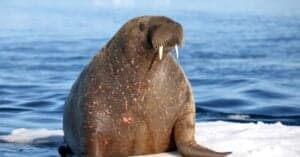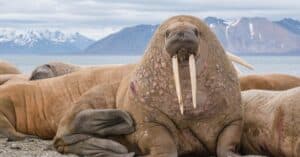Of the semi-aquatic types of mammals inhabiting the coasts of different countries and regions (seals, walruses, and sea lions), walruses might look like they are the most dangerous because of their long tusks which are two of their extra-long canine teeth extending outside their mouths, measuring up to a meter. But contrary to most beliefs, these long tusks are not used to hunt and kill their prey. Instead, these strong canines are used in fighting predators, threatening other walruses, and climbing up on ice and pulling their heavy bodies out of water.
These long tusks also serve a good purpose in pushing enemies and predators away. As massive carnivores, it is easy to assume that walruses feed on huge sea creatures. Although they look like they love to eat flesh, walruses actually love to eat mollusks and clams. Below, we will dive into what walruses like to eat.
What Do Walruses Eat?
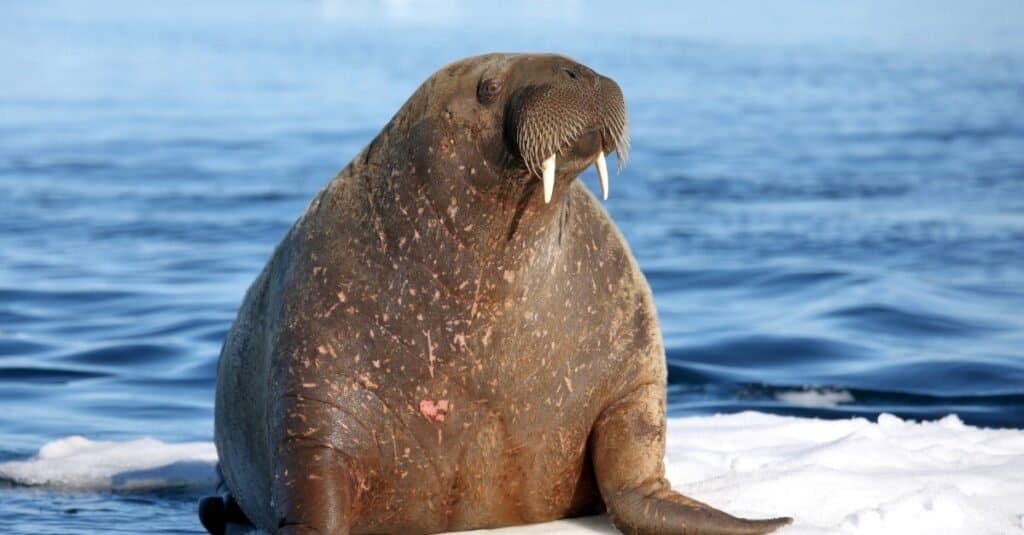
Walruses
eat clams
, crustaceans, mollusks, and fish.
©iStock.com/zanskar
Walruses eat a diet that consists of clams, crustaceans, mollusks, shrimp, fish, and other animals. They are known carnivores but they rarely chase their prey, instead, they prefer to feast on invertebrates like cephalopods and sea cucumbers.
Walruses inhabit the freezing cold waters of the North Pole in the Arctic Ocean. They have distinctive whiskers across their faces, and they possess long tusks that grow outside their mouths, like the structure of a narwhal’s horn. Their feeding behavior lands on the foraging category, as they often forage small invertebrates living on the seafloor of shallow waters. The sea creatures that compose their diet usually inhabit the ocean floor, and can sometimes be difficult to spot since they are buried among the seabed plants.
Walruses are not known to be cannibals, but they have been observed to hunt seals only when there is a shortage of food. They also feed on carcasses of other sea creatures left over by other sea predators, and sometimes on carcasses of seals.
A Complete List of Foods Walruses Eat
Walruses’ food of choice are clams. Yet, they also eat a variety of small invertebrates such as snails, mollusks, sea cucumbers, crabs, and others. They also feed on fish carcasses and some seal species when food is scarce. It is studied that 97% of their diet usually consists of benthic invertebrates.
Here is a complete list of food that walruses eat:
- Clams
- Worms
- Mollusks
- Snails
- Crustaceans
- Soft shell crabs
- Sea cucumbers
- Shrimps
- Gastropods
- Cephalopods
- Fish
- Carcasses
- Seals
- Seabirds.
Walruses sometimes feed on other seals or even narwhals when they find them helpless; that is, when they are trapped by ice. Walruses prefer diving towards the bottom of the ocean to forage for food, as diving is one of their strongest abilities.
Walruses, like most sea mammals, can’t stay underwater for too long. They need to come up above the water time after time to breathe air. They, however, can dive up to 295 feet deep, and can stay at the bottom of the ocean for about 30 minutes. But a study suggests that walruses can dive even deeper than 100 meters, and can swim up to 10 km per hour.
How Much Do Walruses Eat?
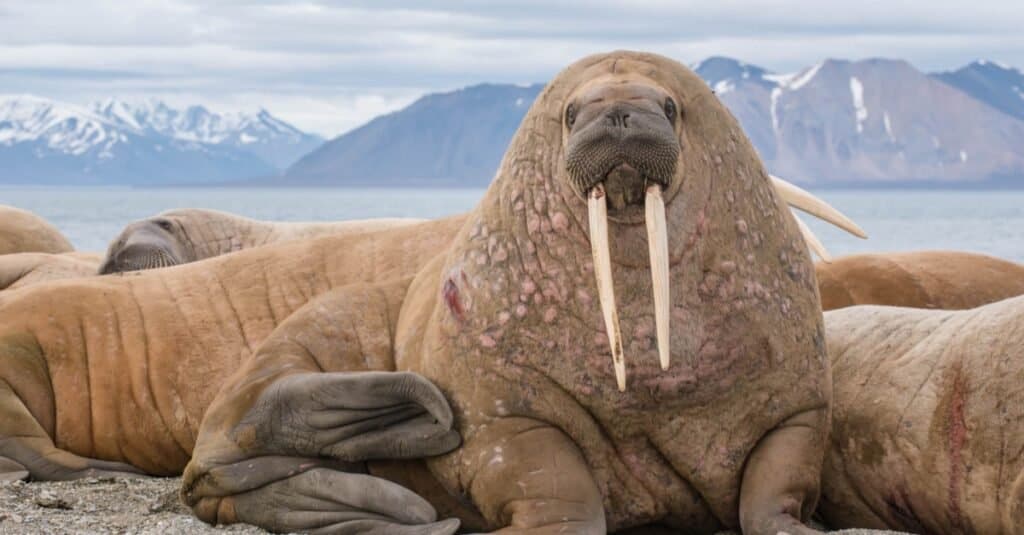
Adult walruses may eat 3,000 to 6,000 clams in one feeding session.
©Mikhail Cheremkin/Shutterstock.com
As walruses often eat small invertebrates, they need tons of them to go through their day. Each time a walrus dives to the ocean floor, it can forage and eat about 60 clams. Adult walruses have been studied to eat 3,000 to 6,000 clams in one feeding session.
Adult male walruses can grow and weigh up to 2 tons, which is also evident in their body sizes. Female walruses, on the other hand, can weigh up to 1,873 pounds. Their skin alone is thick enough to measure up to 6 inches. Given this massive weight, walruses are estimated to eat 3% to 6% of their weight in a day, and studies show that these sea mammals usually eat twice a day. Pregnant walruses eat more food by about 30% to 40%.
Walruses spend most of their time looking for food. They also eat less during winter and spring compared to their regular meal size every summer and fall. Walruses are diurnal sea mammals, which means that they eat during the day and sleep at night.
How Do Walruses Hunt For Food?
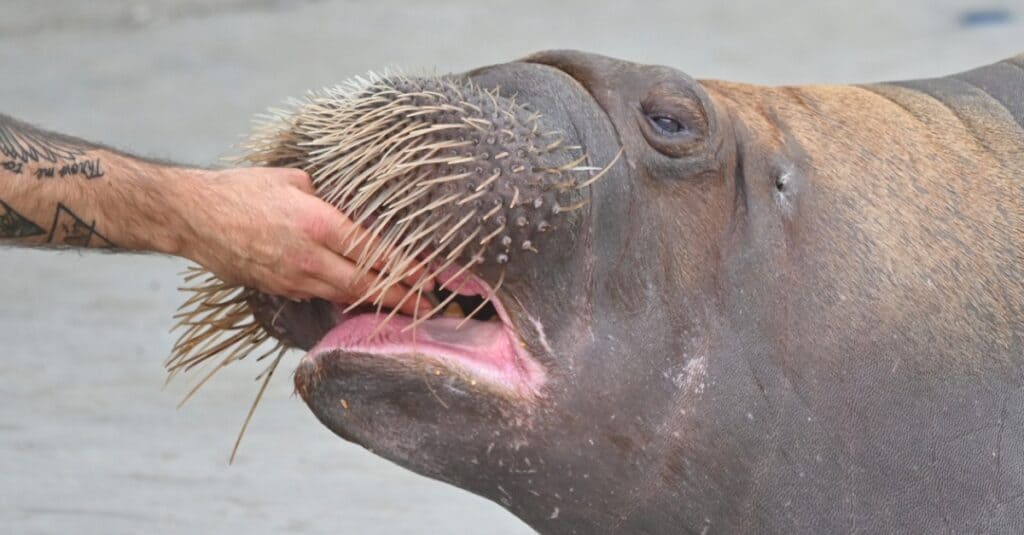
Walruses can eat up to 6,000 clams in one feeding session.
©iStock.com/Dimitri Lefebvre
Walruses forage for food by sweeping the ocean floor, usually within 80 meters deep. Most of their food usually appear between 10 meters to 50 meters down from the water’s surface.
Walruses use their sensitive vibrissae to locate their food. As the ocean waters are usually dark due to lack of direct sunlight, walruses use their vibrissae to vacuum the seabed and detect food. Like other animals with whiskers, a walrus’ vibrissae is specialized to sense its environment. Walruses show abrasion patterns on their whiskers that indicate they drag them through the ocean floor. Their flippers are also helpful in locating food, as they are used to wave on the seafloor to help unveil prey hiding under the sediment.
Apart from their sensitive foraging strategies, walruses are observed to slurp mouthfuls of water and splash it forcefully towards the ocean floor to uncover clams and other burrowed invertebrates.
How Do Walruses Eat?
Although walruses eat a wide variety of food, they mostly prefer clams. Walruses eat clams by sealing their lips onto the clam’s shell and swiftly pulling back their tongues into their mouths to create a vacuum-like move, sucking the fleshy siphon out of their shells.
Like sea lions, walruses do not chew their food, yet they sometimes use their teeth to crush clams, shells, and other small invertebrates they feed on. Scientists have also found remnants of sand, pebbles, and small stones inside the stomachs of walruses as evidence that they might have been swallowing particles of the seafloor as they sweep it off for food.
Summary of What Walruses Eat
Here’s a recap of the foods that walruses commonly consume:
| Number | Food |
|---|---|
| 1 | Clams |
| 2 | Worms |
| 3 | Mollusks |
| 4 | Snails |
| 5 | Crustaceans |
| 6 | Soft shell crabs |
| 7 | Sea cucumbers |
| 8 | Shrimps |
| 9 | Gastropods |
| 10 | Cephalopods |
| 11 | Fish |
| 12 | Seals |
| 13 | Seabirds |
| 14 | Carcasses |
The photo featured at the top of this post is © Mikhail Cheremkin/Shutterstock.com
Thank you for reading! Have some feedback for us? Contact the AZ Animals editorial team.




